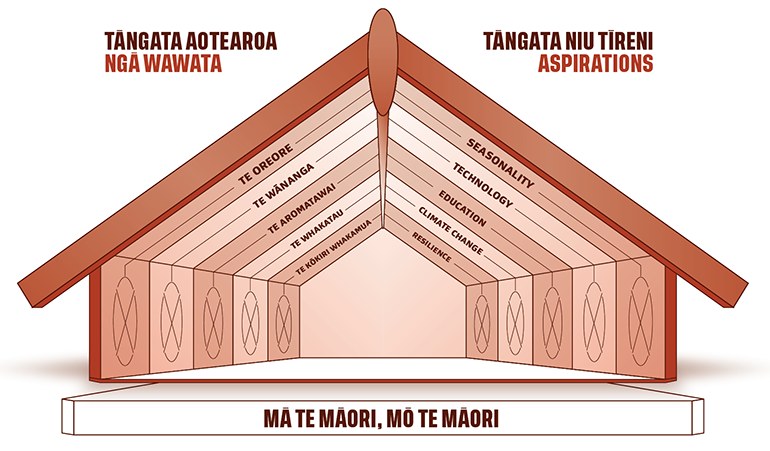The Regional Workforce Whare
On this page
This plan is presented as a Regional Workforce Whare or house that is built on a tūāpapa or foundation of Mā te Māori, Mō te Māori. This foundation acknowledges our Aotearoa New Zealand history of settlement, colonisation and resulting inequities between Māori and non-Māori.
Therefore, our Regional Workforce Whare makes space for a Mana Motuhake, tiriti in action approach that supports the provision of conditions and resources for whānau, hapū, iwi and hapori Māori to plan for the unique Kaupapa Māori of the Māori people, communities and workforce.
The left-hand side heke of the whare symbolises Tāngata Aotearoa aspirations and actions for whānau, hapū, iwi and Māori. These will be whānau-designed, iwi and hapū owned actions.
The right-hand side heke of the whare symbolises Tāngata Niu Tīreni aspirations, actions and outcomes for all the people of the Bay of Plenty.

He tūāpapa
Mā te Māori, mō te Māori
The Group acknowledges the voice of iwi partners in saying that whānau are key to a relevant and successful Bay of Plenty Workforce Plan. Prioritising Mā te Māori, Mō te Māori as the tūāpapa of the workplan is about making space for whānau, hapū, iwi and Māori to mobilise in a way that elevates mātauranga Māori, te reo Māori and tikanga and prioritises regional whānau, hapū, iwi and Māori aspirations and actions.
Iwi partners have said that they want to enable whānau to take charge of their change – Te Tiriti in action. The RSLG recognises Te Tiriti o Waitangi as the founding document of Aotearoa New Zealand. It lays an important foundation for relationships between hapū, iwi, Māori and the Crown.
The RSLG is an independent regionally based advisory body (established by Government to ensure regional voices are considered through the reform of vocational education) that work together with other government and NGO programmes and providers to maximise impact for whānau by connecting jobs opportunities and training. The RSLG recognises iwi and hapū as local partners, has Māori co-chairs and has Māori members from across the rohe.
Te Tiriti o Waitangi provides a basis through which whānau, hapū, iwi and Māori may critically analyse relationships, challenge the status quo, and affirm Māori rights. Iwi partners have made it clear that hapū, iwi and Māori communities expect solutions and initiatives to be by Māori, for Māori and with Māori. Combined leadership of workforce opportunities and training will uplift the overall wellbeing of whānau – their mana, their mauri and their tapu. This mana motuhake approach to a shared, co-designed workplan is key to maximising positive impact for whānau of the Bay of Plenty, particularly rangatahi Māori flourishing.

